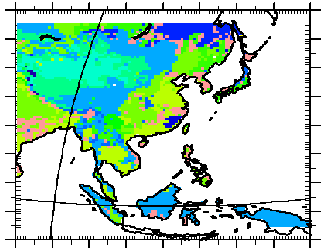|
Mesoscale Chemical
Weather Forecasts in East Asia in Support of Trace-P
Gregory
R. Carmichael & Itsushi Uno2
University
of Iowa, 319/335-3333 (P); 319/335-3337 (F); gcarmich@icaen.uiowa.edu; http://www.cgrer.uiowa.edu/people/carmichael/ACESS/index.html
2 Kyushu
University, 81-92-583-7771 (P); 81-92-583-7774 (F); iuno@riam.kyushu-u.ac.jp ; http://www.riam.kyushu-u.ac.jp/taikai
During the Trace-P experiment we will be
providing forecasts of a variety of trace species. The operational
chemical weather forecasting system is based on 3-D on-line regional
scale chemical transport model fully coupled with RAMS (Regional
Atmospheric Modeling System). This system consists of several important
components: i) operational global forecast data set access to NCEP
(and JMA); ii) RAMS weather forecast for 72 hours based on the
NCEP & JMA data as a lateral boundary conditions; iii) On-line
chemical transport calculation of important chemical tracers; and
iv) post-processing of "chemical weather forecast" results
with 2/3-D graphics into the WWW-page.
|
|
|
|
|
|
|
On-Line
Tracers/Emission Markers:
SO2/sulfate DMS
BC OC
Volcanic SO2 Megacities
CO-fossil fuel CO-biomass
Ethane Ethene
Sea Salt Radon
Lightning NOx Dust
Stratospheric O3
Plus :
Off-line 24 hour forecasts of
Photochemistry
|
|
|
 |
|
|
|
|
|
Three-dimensional
fields for the domain shown and extending up to 15 km will be provided
to support field operations. The primary products will be 2-dimensional
images and quick-time movies showing main features of flow field
and tracer distributions. These will be available over the web.
In addition vis5d files will be downloaded in the field for additional
analysis related to flight planning as well as quick-look analysis
while still in the field. Further details are available at the
websites listed below.
Additional Information:
- data
volume: 30 MB per day
- modes
of data transfer to the field: the basic information will be
provided via our internet website; vis5d files will require download
from our website
- device
requirements: our vis5d files could be made also in CAVE display
format; color printer
is needed
- field
time when data sent to field: first level tracer products available
at 9 am local time; additional products by 3 pm LT
- hours
required to process data in the field (from download to discussion-ready):
minimum time 2 hours
- name(s)
of person in field who will handle your data: Greg Carmichael & Jim
Yienger
- website
URL if Internet download: ; http://www.cgrer.uiowa.edu/people/carmichael/ACESS/index.html & ; http://www.riam.kyushu-u.ac.jp/taikai
- equipment
needed in the field: color printer, FAX
|